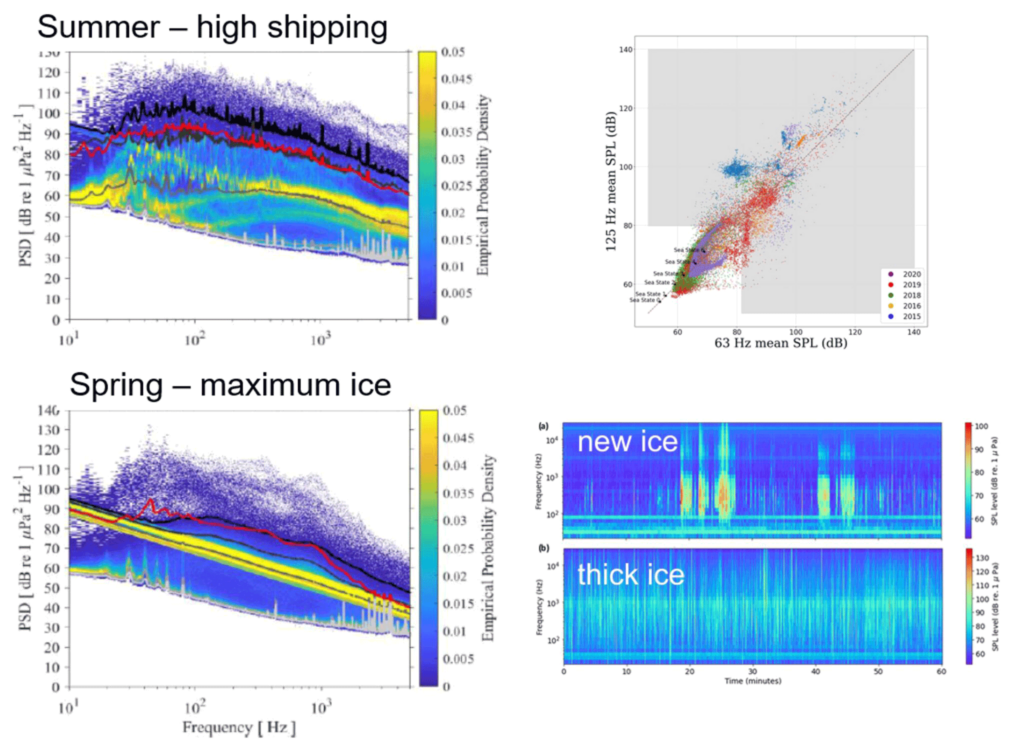Passive Acoustics measures the ambient sounds underwater, and they are extremely varied. Natural sounds include the weather above the surface (rain or snow, storms, winds and waves), the sounds of the ice cover (when it is forming, when it is thick enough to cover the whole surface and when it breaks down again) and even the odd earthquake far away. Animal sounds reflect the diversity of local marine life, from marine mammals to some fish species. There are also sounds from human activities, like shipping (which can be heard far away), snowmobiles close to settlements and other offshore activities. This makes for very rich and complex soundscapes, varying with locations and with days, seasons and years.

Task 3.3 will develop the ways to measure and compare these signatures, using established tools like Power Spectral Densities (standardized across frequency bands), Sound Exposure Levels (to compare with the acoustic sensitivities of different marine animals) and percentile analyses. We use our peer-reviewed open-source package PAMGuide and other techniques like energy detectors, pattern matching and deep learning to identify acoustic signatures of interest. This can be used to assess how soundscapes change with time and with locations, contributing to the other Tasks in this Work Package.
Below are some samples of different acoustic signals from Cleverly and Blondel 2025* (Supplementary Materials).
Bowhead Whale Calls
The bowhead whale is the only mysticete (baleen whale) species endemic to the Arctic Ocean and is well adapted to living in ice-covered waters. It is known for its wide vocal repertoire. During the winter months along the Fram Strait, bowheads produce highly elaborate songs which continuously evolve over time, returning to the region each winter with different songs. This behaviour is associated to mating rituals.
Bowhead calls can be heard further north in the Nansen Basin, but their presence is understudied in the region. Given their low population on the Eurasian side of the Arctic, with estimates of only 340 individuals, monitoring these vocalisations is crucial for conservation efforts.
Bearded Seal Calls
The bearded seal is the largest seal species of the Arctic, preferentially living in areas with moving ice floes. Males of this species produce characteristic mating calls which consist of downward-sweeping trills spanning a range of several kilohertz (only the tail-end of the call is captured above)6 and lasting as long as 90 seconds. Along the Fram Strait and Nansen Basin, these mating calls are common throughout May and June.
There are no definitive estimates of the population of bearded seals as their distribution across the Arctic is sparse and surveys of the species are limited. Climate change poses a great threat on ice-reliant species, so study of vocalisations of the bearded seal and other mammals can infer not only their wellbeing, but habitability of sea ice across the Arctic as well.
Icebreaker Ship Engine Tones
Anthropogenic noise in the Arctic Ocean is a growing concern as economic interest continues to increase. Sound pollution from shipping and industrial activity is a known stressor to marine life (not just whales and seals) and it has a detrimental impact on the health of ecosystems.
Ship engines, alongside any onboard machinery, produce a harmonically rich set of tones, dominating the entire audible frequency range (from below 20 Hz up to 20 kHz), with lower frequencies propagating further. When icebreakers navigate through ice floes, additional noise is created by ice breakup, amounting to sound levels as high as 200 dB re 1 μPa @ 1 m (very close to the source: these sounds will attenuate with range, with the higher frequencies being attenuated the fastest).
Tonal Sounds from Sea Ice
Cryophony, sound from the dynamic processes of sea ice, is a major component of polar underwater soundscapes. From the short broadband ‘pulses’ of ice fracturing to the infrasonic crashing of ice floes colliding, cryophony consists of a diverse range of sounds. Sea ice can also produce long tones with surprising stable harmonics, produced from either ice floes rubbing together (shearing) or from internal deformations.
With climate change, less sea ice will lead to stronger wind-driven currents in shallow water. This will make the remaining ice more dynamic, producing more variable cryophony.
*Supplementary material for the poster presentation:
Automated Processing of Arctic Underwater Soundscapes,
Jonathan Cleverly and Philippe Blondel – Department of Physics, University of Bath,
Arctic Frontiers 2025: Beyond Borders, Tromsø, Norway, 27th-30th January 2025.